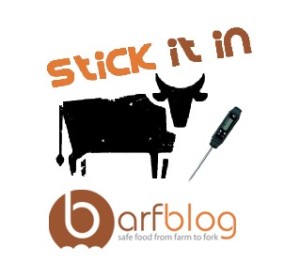Many countries have a Food Safety Week or Month, which seem primarily designed to circulate bad information and blame consumers for getting sick.
.jpg) The U.K. celebrates Food Safety Week 2010 from June 7-13 (I can hear the monster truck radio promo dude doing the voice-over for the commercials – ‘experience the thunder, Food Safety Week 2010 will rock your world’).
The U.K. celebrates Food Safety Week 2010 from June 7-13 (I can hear the monster truck radio promo dude doing the voice-over for the commercials – ‘experience the thunder, Food Safety Week 2010 will rock your world’).
This year, the focus is on Campylobacter, which, at 55,000 reported cases annually, causes the greatest number of foodborne illnesses in the UK. The key messages for this year’s campaign are to cook thoroughly and avoid cross-contamination.
The communication types at the Food Standards Agency (FSA) have come up with a draft press release that local councils could use to promote the good deeds of Food Safety Week (or in bureau-speak, FSW!) entitled, Take simple steps to avoid food poisoning.
If avoiding food poisoning was so simple, why do so many people get sick?
“People should not worry unduly about food poisoning; there are some simple common sense steps people can take to avoid getting ill. Just storing, handling and cooking food properly will minimise the risk.”
Can I duly worry about barfing from the food I eat?
Bob Martin, a food safety expert at the FSA, said,
“Proper cooking will kill food bugs. It’s especially important to make sure poultry, pork, burgers and sausages are cooked all the way through. If there’s any pink meat or the juices have any pink or red in them, germs could be lurking! Check your food is steaming hot all the way through before serving.”
These are not recommendations for proper cooking; these are recommendations for food safety failures. Is steaming hot an improvement on piping hot? How do I .jpg) check if food is steaming hot, won’t I burn something? Do hamburgers and chicken legs steam when they are cooked? Is color really the best way to tell if food is cooked? Why do bureaucrats have to excessively use exclamation marks?
check if food is steaming hot, won’t I burn something? Do hamburgers and chicken legs steam when they are cooked? Is color really the best way to tell if food is cooked? Why do bureaucrats have to excessively use exclamation marks?
As part of the interactive learning section, the British feds ask,
Q4. How can you tell that chicken is properly cooked? (Tick all that apply.)
1. It’s hot on the outside
2. It’s not pink
3. The juices run clear
4. After the time stated on the instructions
5. It’s golden brown
6. It’s steaming hot all the way through
A. It’s not pink, the juices run clear and it’s steaming hot all the way through, 2,3, and 6.
To ensure chicken is properly cooked, you should check the thickest bit of meat, either large pieces in something like a curry, or with a roast bird at the thickest part .jpg) between the breast and leg. The meat should be steaming hot, with no pinkness and any juices should run clear.
between the breast and leg. The meat should be steaming hot, with no pinkness and any juices should run clear.
Check it with your eyes? Your finger? Your tongue? How about, check it with a tip-sensitive digital thermometer because color is a lousy indicator for food safety.
“During 2010, the Agency will be developing a new campylobacter risk management programme. Although this new programme is expected to involve extensive work with industry to reduce the prevalence of campylobacter in UK-produced retail chicken, the promotion of messages about good food hygiene to consumers through initiatives such as Food Safety Week will remain an important factor in reducing human campylobacter infections.”
There is no evidence such information programs do anything but lower the credibility of a supposedly science- or evidence-based agency.
On this Memorial Day, which can be traced back to Decoration Day at the end of the American civil war, stick with some of the cooking advice from the Americans and Canadians – use a tip-sensitive thermometer and stick it in.
.jpg)




.jpg) The U.K. celebrates Food Safety Week 2010 from June 7-13
The U.K. celebrates Food Safety Week 2010 from June 7-13.jpg)